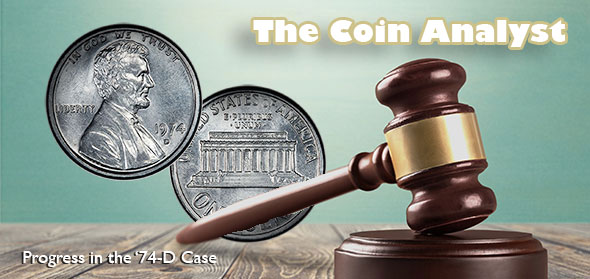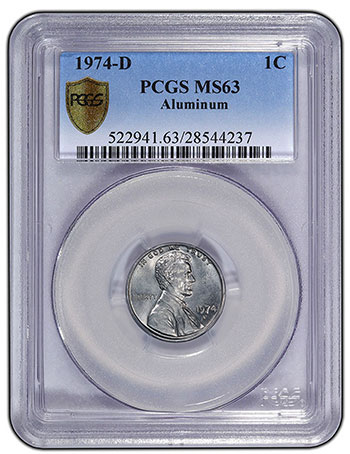
By CoinWeek …..
It looks like Heritage might get to auction that unique 1974-D aluminum cent after all…
Intended to be one of the highlights of Heritage Auctions’ 2014 Central States Numismatic Society Convention Sale, a 1974-D aluminum cent pattern once belonging to an assistant superintendent at the Denver Mint, has been tied up in litigation for more than a year. On March 26, a United States District Court Judge issued a ruling that may clear the way for the coin’s sale.
In 1973, with copper bullion costs on the rise, the United States Mint authorized a series of experiments designed to test the feasibility of alternate planchet compositions for the one-cent coin.
It was during these tests that the U.S. Mint struck more than one million aluminum one-cent coins, all bearing the date 1974. Several hundred of these experimental patterns were shown to Mint and Treasury Officials. Members of Congress were also presented the coins. Ultimately, Congress rejected the composition and nearly all of the 1974 patterns were returned to the Mint and destroyed. However, a few are known to have survived. One resides in the National Numismatic Collection at the Smithsonian Institution in Washington, D.C.
Until last year, most numismatists were unaware of the fact that aluminum cents were also struck at the Denver Mint. The discovery was made after Randall Lawrence, son of the late Henry Lawrence, who served as Assistant Superintendent of the Denver Mint at the time when the experimental coin was struck, sold the specimen to San Diego-based coin dealer Michael McConnell for an undisclosed sum.
 Although no records of the striking survive, reports published on various numismatic websites speculate that between 10 and 14 examples may have been struck. Since the discovery of the Lawrence specimen, no further examples have come forward.
Although no records of the striking survive, reports published on various numismatic websites speculate that between 10 and 14 examples may have been struck. Since the discovery of the Lawrence specimen, no further examples have come forward.
The uniqueness of the 1974-D aluminum cent drew immediate collector interest and national attention. But it also drew unwelcome scrutiny from the United States Mint, which filed suit in Federal Court on March 14, 2014. Seeking the return of the pattern, the Mint alleged that coin’s production was unauthorized and that it was never released to the public.
The government used a similar tactic in 2005 to seize 10 1933 double eagles from the heirs of Philadelphia coin dealer Israel Switt. It is believed that Switt was the source for nine 1933 double eagles that had been sold in the years immediately following the government’s recall of gold coinage.
For collectors of U.S. pattern coinage, the broad scope of the language underpinning the government’s argument against Switt and now McConnell and Lawrence is troubling.
McConnell and Lawrence argued that the experimental coins were authorized and that no coins could have been struck at the facility without “a specific order to do so.” [ID ¶39]
Federal judge William Q. Hayes, agreed with the Plaintiffs, and rebuffed the government’s position, stating that Lawrence could have been given the coin, as claimed, by Mint officials and that his heir’s claim of legal ownership was “plausible” through the drawing of “reasonable inferences.”
Should the government decide to no longer pursue the issue, the controversial 1974-D cent pattern will be cleared to make an appearance on the auction block no worse for wear, and perhaps even more coveted due to its complicated legal history.
Whether it brings as much at auction as the government spent trying to seize it is another story. Makes you wonder why, if they wanted it so bad, they didn’t just bid on it like everyone else.
* * *
Sources
Randall Lawrence and Michael McConnell vs. United States Department of the Treasury; United States Bureau of the Mint; and the United States of America (Case No. 14cv594-WQH-NLS)
* * *





I have long thought that the U.S. government’s and U.S. Mint’s stance on this and similar coins, to be greedy, grasping, illiberal, and uninformed.
Would it, for example, have wanted to destroy any 1933 gold double eagles that turned up? What’s the point? It would be as big an act of vandalism as the recent ISIL terrorists destruction of ancient monuments in the middle east, and similar acts by Al Queda and the Taliban in the past decade.
Wasting taxpayers money by fighting unjust and unfair legal cases should not happen in an enlightened democracy. Why don’t American coin collectors e-mail their senators and congressmen to protest, and get things changed.
As an aside, I long suspected that more 1933 double eagles were lurking somewhere in deposit boxes, so was not surprised when the Switt coins turned up. There are probably still more out there which may come onto the open market if the U.S. government ever relaxes its oppressive attitude towards the people whose interests it pretends to serve and protect.
We have heard rumors that at least two additional 1933 double eagles have traded privately in recent years. How many remain at large is anybody’s guess.
Not to mention 1964 Peace dollars…
It is disturbing to me that the U.S. Government is using
our tax money to chase an aluminum cent ,
While terrorist are trying to infiltrate US shopping malls and kill citizens . So our US Attorney General and his qualified lawyers and prosecutors are spending their (our) time and money trying to confiscate a Lincoln penny instead of going after real criminals ? Come on America ! KO
Tax dollars well spent!
I personally know where one 1933 double eagle coin is. But like you said. Given the government attitude on such things. You could not drag the info out of me.!!!!!!